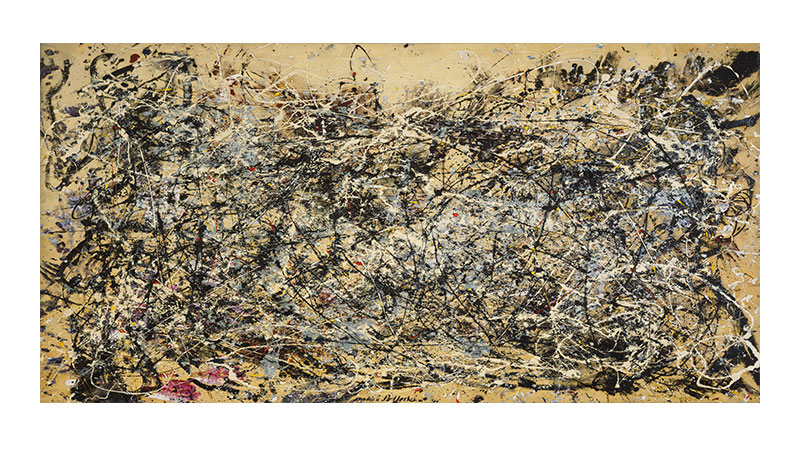American painter Jackson Pollock (1912 – 1955) was one of the leading figures of Abstract ExpressionismThe term Abstract Expressionism is applied to new forms of abstract art developed by American painters such as Mark Rothko, Jackson Pollock, and Willem de Kooning, flourishing between 1943 and the mid-1950s. Since Abstract Expressionism marked the beginning of New York City as the centre of the Western art world, the movement is also known as the New York School. More and the New York School. He is best known for his large action drip paintings, which he produced between 1947 and 1952, created by pouring and manipulating liquid paint atop canvases set on the floor.
Pollock was born in Cody, Wyoming and grew up in Arizona and California. In 1928 he began to study paintingPainting is a fundamental form of visual art that has been practiced for thousands of years. It involves applying pigment to a surface such as canvas, paper, or a wall. Painting can be explored through various styles, techniques, and mediums, each offering unique possibilities for expression and creativity. Historical Background • Ancient Beginnings: The history of painting dates back to More at the Manual Arts High School in Los Angeles. In 1930 he started studying under Thomas Hart Benton at the Art Students League in New York. At this time the murals of José Clemente Orozco and Diego Rivera had a strong impact on Pollock. He found jobs contributing to the Works Progress Administration Federal Art Project and in David Alfaro Siqueiros’s experimental workshop in New York in the mid-1930s. He was supported by Peggy Guggenheim during the 1940s who gave him a contract lasting half a decade, which permitted him to devote all his time to art. His was able to stage his first solo show at Guggenheim’s Art of This Century, New York in 1943.

While prior to 1947 Pollock’s work reflected the influence of SurrealismSurrealism was a 20th-century philosophical, literary, and artistic movement seeking to channel the unconscious to access the imaginary. Proponents of Surrealism rejected the notion of understanding life in rational and conventional terms in favour of asserting the value of the unconscious mind, dreams, the strangely beautiful, and the uncanny. André Breton, the leader of a group of poets and artists More as well as Pablo PicassoPablo Picasso (1881–1973), was a Spanish painter, sculptor, graphic artist, and resident in France from 1904. He was a dominant figure in avant-garde movements in the first half of the 20th century due to his technical versatility and prolific inventiveness. picasso-self-portrait Picasso’s progression in his early work is largely categorized by predominant colour schemes: His Blue Period (1901-1904) features motifs More, as well as of his artist wife Lee Krasner, by the mid-1940s he began paintingPainting is a fundamental form of visual art that has been practiced for thousands of years. It involves applying pigment to a surface such as canvas, paper, or a wall. Painting can be explored through various styles, techniques, and mediums, each offering unique possibilities for expression and creativity. Historical Background • Ancient Beginnings: The history of painting dates back to More in an entirely abstract manner. He liberated himself from paintingPainting is a fundamental form of visual art that has been practiced for thousands of years. It involves applying pigment to a surface such as canvas, paper, or a wall. Painting can be explored through various styles, techniques, and mediums, each offering unique possibilities for expression and creativity. Historical Background • Ancient Beginnings: The history of painting dates back to More at the easel by putting the unstretched canvas on the floor. Developing his signature “drip style” which he is most famous for today, he explored the usage of sticks and knives to splatter paint or pouring paint directly from the can onto the canvas. In line with Surrealist notions of the automatic paintingPainting is a fundamental form of visual art that has been practiced for thousands of years. It involves applying pigment to a surface such as canvas, paper, or a wall. Painting can be explored through various styles, techniques, and mediums, each offering unique possibilities for expression and creativity. Historical Background • Ancient Beginnings: The history of painting dates back to More and the expression of the subconscious, he created decisive foundations for the further development of Abstract ExpressionismThe term Abstract Expressionism is applied to new forms of abstract art developed by American painters such as Mark Rothko, Jackson Pollock, and Willem de Kooning, flourishing between 1943 and the mid-1950s. Since Abstract Expressionism marked the beginning of New York City as the centre of the Western art world, the movement is also known as the New York School. More and contemporary art in general.
IN 1950, Peggy Guggenheim organized Pollock’s first European solo exhibition at the Museo Correr, in Venice, while critic Clement Greenberg organized his first retrospective at Bennington College, Vermont. Pollock further participated in numerous group exhibitions including the Venice Biennale in 1950.
Pollock struggled with mental health issues and suffered several nervous breakdowns throughout his life. He got psychiatric treatment for alcoholism seeing Jungian psychologists and was institutionalized several times. Under the influence of alcohol, he was killed in an automobile accident on August 11, 1956, in East Hampton.
